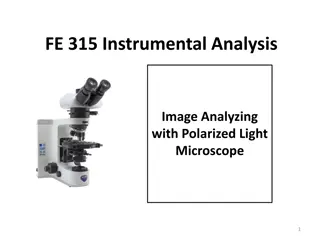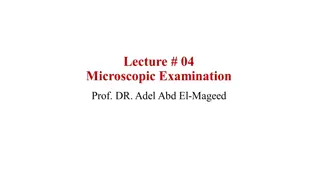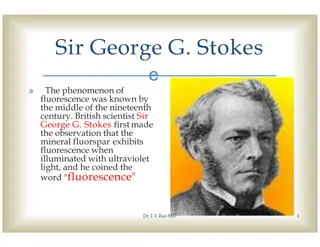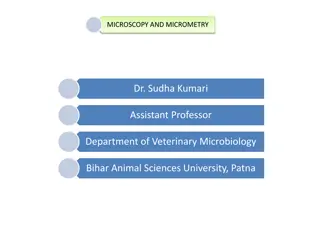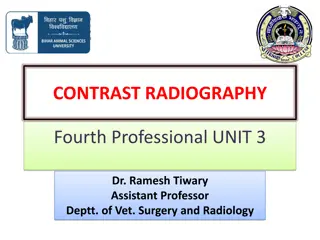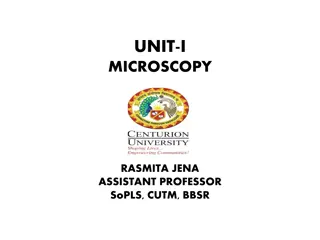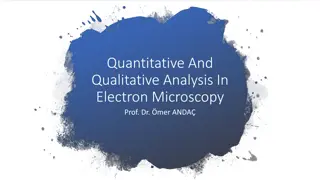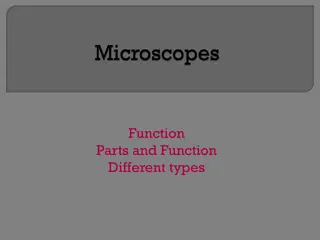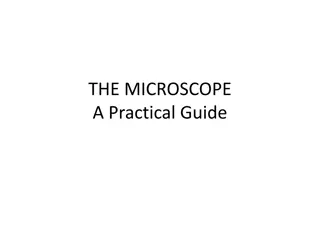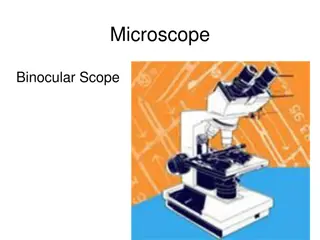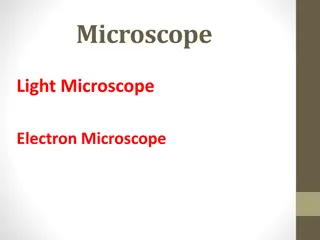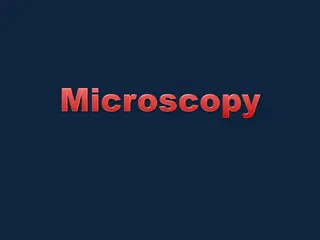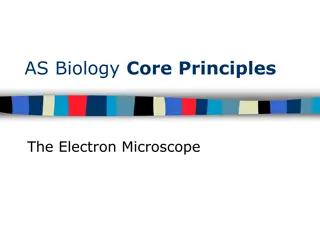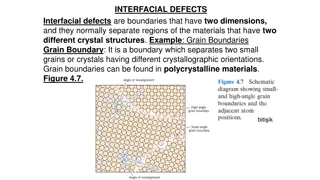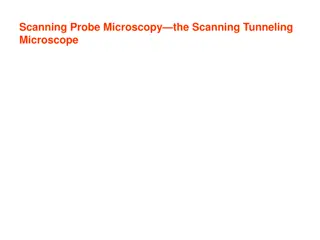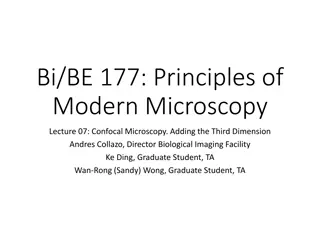Evolution of Microscopes: From Reading Stones to Phase-Contrast Microscopy
The history of microscopes dates back to the 11th century with the invention of the reading stone, leading to the creation of wearable eyeglasses in the 13th century. The first microscope was developed in the late 16th century by Zacharias Jansen, paving the way for the compound microscope and the telescope. Key advancements followed in the 17th and 18th centuries, including the discovery of cells by Robert Hooke and the description of bacteria by Anton van Leeuwenhoek. Innovations by Joseph Jackson Lister and Ernst Abbe improved optical quality, while Richard Zsigmondy and Frits Zernike developed microscopes capable of studying objects at the molecular level.
- Microscope Evolution
- History of Microscopes
- Optical Innovations
- Microscopy Advancements
- Scientific Instruments
Download Presentation

Please find below an Image/Link to download the presentation.
The content on the website is provided AS IS for your information and personal use only. It may not be sold, licensed, or shared on other websites without obtaining consent from the author. Download presentation by click this link. If you encounter any issues during the download, it is possible that the publisher has removed the file from their server.
E N D
Presentation Transcript
Lec1:Introduction to the Microscope What Is Microscope? What Is Microscope?
It is an instrument which deals with too small organisms that they cannot be seen distinctly with the naked eye Microscopes provide the resolution (ability to observe two nearby objects as distinct objects), contrast (ability to detect different regions of the specimen on the basis of intensity or color) and magnification (ability to make small objects visible). The human eye can resolve objects of the order of 0 0. .1 1 mm while the light microscope can resolve objects on the order of 0 0. .2 2 m m (200 nm) with a magnification of 1000 transmission electron microscope, can resolve objects on the order of 0.1nm (100 observer with enhanced mm, 1000. The 100 A A units).
For example, their typical linear dimensions are: Animal cell (20 30 m), a red blood cell (7.8 m ), a mitochondrion (2 5 m), a nucleus (3-10 m), microvilli (1 m), a cell membrane (10 nm), a microfilament (8 10 nm), a bacterium )0.5-5 m) and a virus (10 100 nm) Credit for the first microscope is usually given to Zacharias Jansen, in Middleburg, Holland, around the year 1595. Microscope History 1000AD The first vision aid was invented (inventor unknown) called a reading stone. It was ;a glass sphere that magnified when laid on top of reading materials. 1284 - Italian, Salvino D'Armate is credited with inventing the first wearable eye glasses.
1590 Two Dutch eye glass makers, Zaccharias Janssen and son Hans Janssen experimented with multiple lenses placed in a tube. The Janssens observed that viewed objects in front of the tube appeared greatly enlarged, creating both the forerunner of the compound microscope and the telescope. 1665 English physicist, Robert Hooke looked at a sliver of cork through a microscope lens and noticed some "pores" or "cells" in it. 1674 Anton van Leeuwenhoek built a simple microscope with only one lens to examine blood, yeast, insects and many other tiny objects. Leeuwenhoek was the first person to describe bacteria. 18th century Technical innovations improved microscopes, leading to microscopy becoming popular among scientists. Lenses combining two types of glass reduced the "chromatic effect" the disturbing halos resulting from differences in refraction of light. 1830 Joseph Jackson Lister: reduces spherical aberration or the "chromatic effect" by showing that several weak lenses used together at certain distances gave good magnification without blurring the image. This was the prototype for the compound microscope.
1872 Ernst Abbe wrote a mathematical formula called the "Abbe Sine Condition". His formula provided calculations that allowed for the maximum resolution in microscopes possible. 1903 Richard Zsigmondy developed the ultra microscope that could study objects below the wavelength of light. He won the Nobel Prize in Chemistry in 1925. 1932 Frits Zernike invented the phase-contrast microscope that allowed for the study of colorless and transparent biological materials for which he won the Nobel Prize in Physics in 1953. 1931 Ernst Ruska co-invented the electron microscope for which he won the Nobel Prize in Physics in 1986. An electron microscope depends on electrons rather than light to view an object, electrons are speeded up in a vacuum until their wavelength is extremely short, only one hundred thousandth that of white light. Electron microscopes make it possible to view objects as small as the diameter of an atom. 1981 Gerd Binnig and Heinrich Rohrer invented the scanning tunneling mi roscope that gives three-dimensional images of objects down to the atomic level. Binnig and Rohrer won the Nobel Prize in Physics in 1986.
Microscope Types 1. Compound Microscope Compound microscopes are light illuminated. The image seen with this type of microscope is two dimensional. This microscope is the most commonly used. You can view individual cells, even living ones. It has high magnification. However, it has a low resolution. 2. Dissecting Microscope (also called stereo microscope) A dissecting microscope is light illuminated. The image that appears is three dimensional. It is used for dissection to get a better look at the larger specimen. You cannot see individual cells because it has a low magnification. 3. Scanning Electron Microscope (SEM) SEM use electron illumination. The image is seen in 3-D. It has high magnification and high resolution. The specimen is coated in gold and the electrons bounce off to give you an exterior view of the specimen. The pictures are in black and white.
4. Transmission Electron Microscope (TEM) TEM is electron illuminated. This gives a 2-D view. Thin slices of specimen are obtained. The electron beams pass through it. It has high magnification and high resolution. The Light Microscope (Optical Microscope) Our eyes cannot focus on objects nearer than about 25 cm or 10 inches. We overcome this limitation by using a convex lens as a simple magnifier (or microscope) and holding it close to the object. Because microbiology deals with too small organisms they cannot be seen distinctly with the unaided eye, the microscope is essential. The light microscope is the single one of the most important research tool that microbiologists have ever had. The light microscope is an optical instrument which operates on the principal that light energy will pass through and around a suitably thin object, and with the aid of lenses form a magnified impression on the visual sensory layer of the eye.
In order to know how the microscope works we must first have a basic understanding about how lenses bend and focus light to form images. When light energy passes from one medium to another (i.e. AIR and GLASS) the light rays are bent at the point of interface. This process is called refraction. The measure of how greatly a substance slows the velocity of light is called the refractive index The direction and magnitude of bending is determined by the refractive indexes of the two media forming the interface. As parallel rays of light encounter a convex lens, they are slowed and bent towards the normal path. The point at which these rays converge is called the focal point The distance between the center of the lens and the focal point is called the focal length. The strength of a lens is directly related to its focal length. A lens with a short focal length has a greater capacity for magnification than a lens with a longer focal length.
Anatomy of a compound Microscope 1. lamp (light source) 2. Substage Condenser: Used to vary the intensity of light. 3. Diaphram: Modulates the amount of light that passes through the slide. 4. Stage and microscope slide with specimen 5. Objective lenses (usually 10X, 40X, and 100X) on revolving nosepiece 6. Body tube 7. Ocular lens (usually 10X) Microscope Care Always carry with 2 hands Never touch the lenses with your fingers. Only use lens paper for cleaning When you are finished with your "scope", rotate the nosepiece so that it's on the low power objective, roll the stage down to lowest level
Using the Microscope The proper way to focus a microscope is to start with the lowest power objective lens first and while looking from the side, put the lens down as close to the specimen as possible without touching it. Now, look through the eyepiece lens and focus upward only until the image is sharp. If you can't get it in focus, repeat the process again. Once the image is sharp with the low power lens, you should be able to simply click in the next power lens and do minor adjustments with microscope has a fine focus adjustment, turning it a little bit should be all that's subsequent objective lenses and fine focus each time. Using High Power Rotate to 40x objective, locate desired portion of specimen in the center of the field. Refocus very carefully so that the specimen is focused as sharply as possible. (Do not alter focus for the Following steps) Partially rotate so that 40x and 100x objectives include the specimen. the focus knob. If your necessary. Continue with
Place a small drop of oil on the slide in the center of the lighted area. (Take care not to drop on the stage.) Put the small drop of oil directly over the area of the specimen to be examined. Rotate so that the 100x oil immersion objective touches the oil and clicks into place. Focus only with fine focus. Hopefully, the specimen will come into focus easily. Do not change focus dramatically. Clean up: When you have finished for the day, wipe the 100x oil immersion objective carefully with lens paper to remove all oil. Wipe oil from the slide thoroughly with a Kim wipe. Types of Light Microscope There are a variety of light microscopes mostly employed in Microbiology: Bright-field Dark-field Phase-contrast Fluorescence
1-The Bright-field Microscope Called the ordinary microscope because it forms a dark image against a brighter background. Image should remain in focus when objectives are changed. The objective lens forms an enlarged real image within the microscope and the eyepiece lens further magnifies this primarily image. Upon looking in the microscope, the enlarged specimen image )Virtual image (appears to lie just beyond the stage about 25 cm away. Total magnification is calculated objective and eyepiece magnification together. Three factors determine the quality of an optical image: a. Magnification b. Resolution c. Contrast. by multiplying the
Magnification is the apparent increase in size affected by a convex lens. A compound microscope uses two sets of lenses, with differing focal lengths, to facilitate magnification. The total magnification achieved by the lens array is the product of each individual lens. Magnification (total) = magnification (obj. lens) x magnification (ocu. lens) Example: Mag (obj) = 40X and Mag (ocular) = 10X Then Mag (total) = (40X) (10X) = 400X. It is much easier to make two lenses with average magnifying powers and put them together in a compound microscope than to make a single lens with a very high magnifying power. Compound microscopes are usually designed to give a highest possible magnification of only 1,000-1,500X. Resolution The most important part of the microscope is the objective, which must produce a clear image, not just a magnified one. Resolution is the ability to separate points (in other words, to observe fine detail). or the ability of a lens to distinguish between small objects that are close together. Resolution is not the same thing as magnification.
One of the ways to increase the resolution of an image is to increase the amount of light that enters the objective lens by using immersion oil. We have already discussed Refraction, that is the deflection of a light ray that occurs when it passes between substances that have different densities. A convex lens exploits refraction to focus light at a specific point. However not all refraction results in the convergence of light, in many cases, the rays of diverge, which results in an overall decrease in the intensity of light. This typically occurs as light passes through the air, in the space between the specimen and the objective lens. Immersion oil (with a density closer to glass) can be used to reduce the refraction of light rays (compared to air) and allows more light to enter the objective. This improves resolution. Only the highest power (100X) objective on the microscope is designed for use with immersion oil. DO NOT USE OIL WITH THE LOWER POWER (10X AND 40X) OBJECTIVES. Another way to increase resolution of an image is to decrease the wavelength of light that is used to illuminate the specimen (use blue light instead of white light).
Contrast Microbes are composed of water, nucleic acids, proteins, and lipids. Most appear colorless against a colorless background when observed using bright field microscopy. Therefore in order to see them, we must devise a way to increase the contrast. Direct staining of the microorganisms and Indirect (negative) staining of the background In order to stain a specimen, it must first be fixed to the slide and chemically altered. This results in the death of a specimen. Additional microscopic techniques have been developed to increase contrast of living microorganisms:- Dark-field microscopy is one such technique that is often used to observe living, unstained cells and organisms. Dark field microscopes illuminate the sample in such a way that unreflected, and unrefracted light does not enter the objective, only light that has been reflected/refracted by the specimen passes through the objective and forms the image. This results in a specimen that is brilliantly illuminated on a dark field, The field surrounding the specimen appears black.
Phase-contrast microscopes Convert slight differences in refractive index and density into variations in light intensity. Fluorescence microscopy Specimens are treated with dye molecules called fluorochromes which brightly fluoresce when exposed to light of a specific wavelength.
Homework question What's the name of microscope uses in most clinical laboratories and why it is favored more than the others


